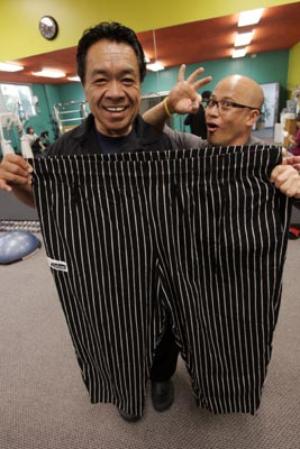Media
The Incredible Shrinking Sam
This article originally appeared in the Honolulu Star Bulletin in December 2009
The Incredible Shrinking Sam (Honolulu Star Bulletin) - December 2009
By Betty Shimabukuro
If there's a downside to losing weight — lots and lots of weight, that is — it's that some people think you must be sick.
"I've had calls coming in — 'Is he dying, is he on drugs, does he have cancer?'" Sam Choy relates.
No, no and no. He's just getting skinny. From a top weight of 405 pounds, Choy was down to 240 at his last visit to the doctor Nov. 30. On occasion he'll dip down as low as 210, he says, which makes him practically half a Sam.
 His goal is 185 pounds, about what he weighed as a football player for Kahuku High School.
His goal is 185 pounds, about what he weighed as a football player for Kahuku High School.
Choy, age 57 and 5 feet 7 inches tall, is one of Hawaii's best-known chefs — and had been one of its biggest. What brought about this turnaround?
"I thought I was going to die," Choy says of a point in time about three years ago. "I was in bad shape. My body was looking gray. I walked 10 feet and I started perspiring."
Not that he hadn't had warnings. Shortly after turning 50, Choy's blood pressure, cholesterol and blood sugar, which had been borderline for years, all reached scary levels. He started an aggressive exercise program but, after an injury, slacked off.
In 2006, though, his type 2 diabetes had reached the point where he'd have to go from pills to insulin, Choy says, and that's the one thing that really frightened him.
"I've seen people go from insulin injections to dialysis to amputations. ... The bottom line is, you gotta do something. If you don't, what's the end result? You become a burden on the family."
He found a personal trainer, Eric Yamashita, and in early 2007 began a structured diet and exercise program. Choy lost 100 pounds in the first year, Yamashita says, and he has steadily continued to lose.
In recent months Time magazine and USA Today have reported on a dieting trend among U.S. chefs, including such high-profile plus-size personalities as Alex Stratta and Alton Brown. But none of them started out as heavy as Choy, nor did they speak of results as dramatic.
Choy was too heavy to be weighed on the scale in his doctor's office, he says, and had to get on a freight scale instead. When he flew he had to use a seat belt extension.
"The day he finally got to use a regular seat belt, he cried," Yamashita says.
Adds Choy, "That was a very rewarding moment for me."
As the new year approaches and many people make resolutions to lose weight, these chefs could serve as inspiration. Choy warns, however, that it won't be quick or easy.
Even weight loss surgery, which Choy considered but opted against, requires a permanent restrictive diet, he says. There simply is no magic bullet.
Choy works out five to six days a week, for an hour and 45 minutes per session, at The Club when he's home in Kona, or at Yamashita's Balance Core in Kaimuki when he's tending to business on Oahu. Core and cardio are his routine, with stretching and a workout on the elliptical machine followed by weights. Some days they'll use resistance bands; other days, a medicine ball.
"We mix it up so I don't get bored."
He eats his "three squares" a day, with dinner being the smallest meal. In between he'll snack on fruit with a little protein such as cottage cheese or yogurt. "I eat salads, I eat chicken, fish and I eat a lot of tofu," Choy says. "Tofu has become my best friend."
Compare this with his previous eating pattern: "I would get up in the morning, make five cups of rice, take a shower. Then I'd scramble me a dozen eggs, fry a dozen strips of bacon, use half a bottle of ketchup and eat that with three cups of rice."
By noon the rest of the rice would be gone, eaten with leftovers or just with gravy.
He tried switching to brown rice, "but I still ate five cups of that — no difference."
These days he eats very little of what he calls "my killer" — rice. "One or two spoons, that's it," he says. "I haven't got the love for it like I used to."
Yamashita, Choy's trainer, says Choy's greatest challenge is that he travels so much to appear at food events or on television shows.
His assistant, Sally Watanabe-Kim, discusses Choy's diet with his hosts on the other end and tries to book him into hotels with exercise rooms.
"We made sure he was accountable," Yamashita says. "We'd call ahead, and we'd talk to the Food Network and tell them not to take him to eat, take him to the gym."
His commitment to exercise and diet will have to be permanent, Yamashita says. "In six months he could gain 100 pounds back. Easily."
Choy swears that won't happen. "This is it. If you see me drifting, you slap me in the ears or kick me in the okole."
Choy's doctor, Eugene Wong, says Choy is off all the medications he had been taking for the health problems that typically come with obesity. It's a level of improvement Wong rarely sees among his patients.
"Even though they have diabetes, high blood pressure, high cholesterol, it doesn't cause pain so they don't pay heed."
Perhaps Choy, with his high celebrity factor, can change attitudes, Wong says. "He's such an ambassador. Maybe he can be an ambassador for weight control, too."
So how does it feel to be in your best shape in 30 years?
"Great," Choy says. "You wanna dance?"
